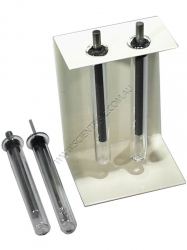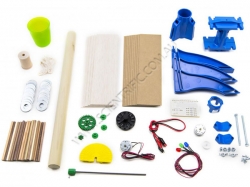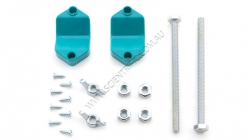109 low relevance results shown for 'cell'. Prev |1|2|3|4|5 | Next | View 100 per page
Showing low relevance matches only. Return to normal search results
Cells - Cells are the basic units of living things and have specialised structures and functions ACSSU150 Year 8 Biological Sciences
Organ Systems - Multi-cellular organisms contain systems of organs that carry out specialised functions that enable them to survive and reproduce ACSSU175 Year 9 Biological Sciences
Organ Systems - Multi-cellular organisms rely on coordinated and interdependent internal systems to respond to changes to their environment ACSBL045 Year 11 Cells and multicellular organism
Cells as the basis of life - The cell membrane separates the cell from its surroundings and controls the exchange of materials, including gases, nutrients and wastes, between the cell and its environment ACSBL046 Year 11 Cells and multicellular organism
Cells as the basis of life - Movement of materials across membranes occurs via diffusion, osmosis, active transport and/or endocytosis ACSBL047 Year 11 Cells and multicellular organism
Cells as the basis of life - Factors that affect exchange of materials across membranes include the surface-area-to-volume ratio of the cell, concentration gradients, and the physical and chemical nature of the materials being exchanged ACSBL118 Year 12 Maintaining the internal environment
Infectious disease - Pathogens have adaptations that facilitate their entry into cells and tissues and their transmission between hosts; transmission occurs by various mechanisms including through direct contact, contact with body fluids, and via contaminated food, water or d ACSCH103 Year 12 Equilibrium acids and redox reactions
Oxidation and reduction - A range of reactions, including displacement reactions of metals, combustion, corrosion, and electrochemical processes, can be modelled as redox reactions involving oxidation of one substance and reduction of another substance ACSCH104 Year 12 Equilibrium acids and redox reactions
Oxidation and reduction - Oxidation can be modelled as the loss of electrons from a chemical species, and reduction can be modelled as the gain of electrons by a chemical species; these processes can be represented using half equations ACSCH106 Year 12 Equilibrium acids and redox reactions
Oxidation and reduction - The relative strength of oxidising and reducing agents can be determined by comparing standard electrode potentials ACSCH107 Year 12 Equilibrium acids and redox reactions
Oxidation and reduction - Electrochemical cells, including galvanic and electrolytic cells, consist of oxidation and reduction half reactions connected via an external circuit that allows electrons to move from the anode (oxidation reaction) to the cathode (reduction reaction) ACSCH108 Year 12 Equilibrium acids and redox reactions
Oxidation and reduction - Galvanic cells, including fuel cells, generate an electrical potential difference from a spontaneous redox reaction; they can be represented as cell diagrams including anode and cathode halfequations ACSCH110 Year 12 Equilibrium acids and redox reactions
Oxidation and reduction - Cell potentials at standard conditions can be calculated from standard electrode potentials; these values can be used to compare cells constructed from different materials ACSBL052 Year 11 Biodiversity and the interconnectedness of life
Ecosystem dynamics - Photosynthesis is a biochemical process that in plant cells occurs in the chloroplast and that uses light energy to organic compounds; the overall process can be represented as a balanced chemical equation ACSBL053 Year 11 Biodiversity and the interconnectedness of life
Ecosystem dynamics - Cellular respiration is a biochemical process that occurs in different locations in the cytosol and mitochondria and metabolises organic compounds, aerobically or anaerobically, to release useable energy in the form of ATP; the overall process can be repr























109 low relevance results shown for 'cell'. Prev |1|2|3|4|5 | Next | View 100 per page
Showing low relevance matches only. Return to normal search results
Curriculum resources related to 'cell'
ACSSU149 Year 8 Biological SciencesCells - Cells are the basic units of living things and have specialised structures and functions ACSSU150 Year 8 Biological Sciences
Organ Systems - Multi-cellular organisms contain systems of organs that carry out specialised functions that enable them to survive and reproduce ACSSU175 Year 9 Biological Sciences
Organ Systems - Multi-cellular organisms rely on coordinated and interdependent internal systems to respond to changes to their environment ACSBL045 Year 11 Cells and multicellular organism
Cells as the basis of life - The cell membrane separates the cell from its surroundings and controls the exchange of materials, including gases, nutrients and wastes, between the cell and its environment ACSBL046 Year 11 Cells and multicellular organism
Cells as the basis of life - Movement of materials across membranes occurs via diffusion, osmosis, active transport and/or endocytosis ACSBL047 Year 11 Cells and multicellular organism
Cells as the basis of life - Factors that affect exchange of materials across membranes include the surface-area-to-volume ratio of the cell, concentration gradients, and the physical and chemical nature of the materials being exchanged ACSBL118 Year 12 Maintaining the internal environment
Infectious disease - Pathogens have adaptations that facilitate their entry into cells and tissues and their transmission between hosts; transmission occurs by various mechanisms including through direct contact, contact with body fluids, and via contaminated food, water or d ACSCH103 Year 12 Equilibrium acids and redox reactions
Oxidation and reduction - A range of reactions, including displacement reactions of metals, combustion, corrosion, and electrochemical processes, can be modelled as redox reactions involving oxidation of one substance and reduction of another substance ACSCH104 Year 12 Equilibrium acids and redox reactions
Oxidation and reduction - Oxidation can be modelled as the loss of electrons from a chemical species, and reduction can be modelled as the gain of electrons by a chemical species; these processes can be represented using half equations ACSCH106 Year 12 Equilibrium acids and redox reactions
Oxidation and reduction - The relative strength of oxidising and reducing agents can be determined by comparing standard electrode potentials ACSCH107 Year 12 Equilibrium acids and redox reactions
Oxidation and reduction - Electrochemical cells, including galvanic and electrolytic cells, consist of oxidation and reduction half reactions connected via an external circuit that allows electrons to move from the anode (oxidation reaction) to the cathode (reduction reaction) ACSCH108 Year 12 Equilibrium acids and redox reactions
Oxidation and reduction - Galvanic cells, including fuel cells, generate an electrical potential difference from a spontaneous redox reaction; they can be represented as cell diagrams including anode and cathode halfequations ACSCH110 Year 12 Equilibrium acids and redox reactions
Oxidation and reduction - Cell potentials at standard conditions can be calculated from standard electrode potentials; these values can be used to compare cells constructed from different materials ACSBL052 Year 11 Biodiversity and the interconnectedness of life
Ecosystem dynamics - Photosynthesis is a biochemical process that in plant cells occurs in the chloroplast and that uses light energy to organic compounds; the overall process can be represented as a balanced chemical equation ACSBL053 Year 11 Biodiversity and the interconnectedness of life
Ecosystem dynamics - Cellular respiration is a biochemical process that occurs in different locations in the cytosol and mitochondria and metabolises organic compounds, aerobically or anaerobically, to release useable energy in the form of ATP; the overall process can be repr
Products related to 'cell'

IEC Electrode In Glass Norwood Set 4
IEC NORWOOD ELECTRODES IN GLASS SET 4
The IEC Norwood electrodes set includes a stainless steel electrode and a platinum electrode for various experiments in electrolysis plus two carbon electrodes for EMF or Redox cells. Each electrode is mounted in its own glass sleeve ...
Order code: EM1800-001

IEC Potentiometer Wire Wound 20 ohm
IEC POTENTIOMETER WIRE WOUND 20 OHM
The small radio type rotary IEC Potentiometer or Rheostat is a general purpose device for electrical or electronic experiments. It is mounted in a strong transparent container as used in the excellent EM1763-001 IEC Electricity Kit, wit...
Order code: EM2490-001

IEC Potentiometer Wire Wound 50 ohm
IEC POTENTIOMETER WIRE WOUND 50 OHM
The small radio type rotary IEC Potentiometer or Rheostat is a general purpose device for electrical or electronic experiments. It is mounted in a strong transparent container as used in the excellent EM1763-001 IEC Electricity Kit, wit...
Order code: EM2490-003

IEC Potentiometer Wire Wound 100 ohm
IEC POTENTIOMETER WIRE WOUND 100 OHM
The small radio type rotary IEC Potentiometer or Rheostat is a general purpose device for electrical or electronic experiments. It is mounted in a strong transparent container as used in the excellent EM1763-001 IEC Electricity Kit, wi...
Order code: EM2490-005

IEC Potentiometer Wire Wound 1K ohm
IEC POTENTIOMETER WIRE WOUND 1K OHM
The small radio type rotary IEC Potentiometer or Rheostat is a general purpose device for electrical or electronic experiments. It is mounted in a strong transparent container as used in the excellent EM1763-001 IEC Electricity Kit, wit...
Order code: EM2490-010

IEC Potentiometer Wire Wound 10K ohm
IEC POTENTIOMETER WIRE WOUND 10K OHM
The small radio type rotary IEC Potentiometer or Rheostat is a general purpose device for electrical or electronic experiments. It is mounted in a strong transparent container as used in the excellent EM1763-001 IEC Electricity Kit, wi...
Order code: EM2490-015

IEC Potentiometer Carbon 25K ohm
IEC POTENTIOMETER CARBON 25K OHM
The small radio type rotary IEC Potentiometer or Rheostat is a general purpose device for electrical or electronic experiments. It is mounted in a strong transparent container as used in the excellent EM1763-001 IEC Electricity Kit, with 4...
Order code: EM2490-018

IEC Potentiometer Carbon 50K ohm
IEC POTENTIOMETER CARBON 50K OHM
The small radio type rotary IEC Potentiometer or Rheostat is a general purpose device for electrical or electronic experiments. It is mounted in a strong transparent container as used in the excellent EM1763-001 IEC Electricity Kit, with 4...
Order code: EM2490-020

IEC Potentiometer Carbon 100K ohm
IEC POTENTIOMETER CARBON 100K OHM
The small radio type rotary IEC Potentiometer or Rheostat is a general purpose device for electrical or electronic experiments. It is mounted in a strong transparent container as used in the excellent EM1763-001 IEC Electricity Kit, with ...
Order code: EM2490-025

Solar Kit Educational Motor 0.45V
Small low power motor for use with fan blades and solar cells.
Nominal dimensions:
Overall length 41mm
Diameter 23.5
Spindle diameter 1.9mm
Spindle length 6.5mm
Order code: GE4055-01

Vernier Exercise Heart Rate Strap
VERNIER EXERCISE HEART RATE STRAP
The Vernier Exercise Heart Rate Strap is used with a Polar Transmitter Module (HR-TRANS sold separately) https://scientrific.com.au/product.php?p=10133
This is an excellent hands-free option for continuously monitoring heart rate before...
Order code: HR-STRAP

Laser Education Kit
Limited stock
Laser Pointer Education Kit. An inexpensive experiment kit for use with most laser pointers. This economical kit is packaged so that each student has their personal optics kit to study important concepts of light, colour and light waves using standard laser pointers. The mult... Order code: IF-45-211
Laser Pointer Education Kit. An inexpensive experiment kit for use with most laser pointers. This economical kit is packaged so that each student has their personal optics kit to study important concepts of light, colour and light waves using standard laser pointers. The mult... Order code: IF-45-211

Key Experiment - Photosynthesis and Respiration Rates
Description:
KEBS3A investigates changes in rates of photosynthesis under different light conditions.
Curriculum Topics:
• Biology: Cells as the basis of life
Principle:
• Plants make sugar, storing the energy of the sun into chemical energy, by the ...
Order code: KEBS3A

KidWind Basic Wind Experiment Classroom Pack
KIDWIND BASIC WIND EXPERIMENT CLASSROOM PACK
The classroom pack option includes three turbine towers and bases, three nacelles, three generators, eight hubs and blade consumables for eight groups of 2–4 students.
Explore wind energy affordably and easily. This kit, on...
Order code: KW-BWXC

KidWind Drivetrain Set
KIDWIND DRIVETRAIN SET
Connect a wind turbine hub to a nacelle with a drivetrain set.
The KidWind Drivetrain Set features the hex driveshaft, Hub Quick Connect, hex locks and wooden spool used in the KW-AWX Advanced Wind Experiment Kit. These materials can be very helpfu...
Order code: KW-DS

KidWind Motor Mount Pack
KIDWIND MOTOR MOUNT PACK
The KidWind Motor Mount Pack holds the motor (generator) in place when affixed to the wind turbine nacelle. The Motor Mount Pack can be used to replace lost parts from a nacelle. It can also be used to mount a nacelle to the tower for a vertical a...
Order code: KW-MTRMNT

KidWind Mini Wind Turbine
KIDWIND MINI WIND TURBINE
Demonstrate the power of the wind with an affordable and rugged wind turbine. This is an easy-to-build turbine that will light an LED bulb and play a tune. The highly efficient blades will produce plenty of power in a slight breeze.
With th...
Order code: KW-MWT


KidWind Mini Wind Turbine With Blade Design
KIDWIND MINI WIND TURBINE WITH BLADE DESIGN
The MINI Wind Turbine with Blade Design allows students to perform experiments using a desktop fan to demonstrate the power of the wind. This is an affordable, rugged and easy-to-build turbine that will light a LED bulb or play ...
Order code: KW-MWTBD

KidWind SimpleGEN
KIDWIND SIMPLEGEN
The KidWind simpleGEN is an easy-to-build AC generator that allows students to explore the basics of electrical generator design. With the simpleGEN, you can demonstrate Faraday’s law, light LEDs and perform experiments that explore how coils, magnets an...
Order code: KW-SGEN

KidWind SimpleGEN - Classroom Pack
KIDWIND SIMPLEGEN CLASSROOM PACK
The KidWind simpleGEN is an easy-to-build AC generator that allows students to explore the basics of electrical generator design. With the simpleGEN, you can demonstrate Faraday’s law, light LEDs and perform experiments that explore how co...
Order code: KW-SGENC

KidWind Tower and Base Set
KIDWIND TOWER AND BASE SET
Need a tower for your KidWind turbine nacelle? Here is the same tower that comes in KidWind wind kits. This wooden tower has a diameter that will fit nicely inside 25mm PVC fittings.
NOTE: This kit only includes the wooden tower and plastic b...
Order code: KW-TBS

IEC Rocker Switch SPDT on Base with Low Profile 4mm Banana Sockets
IEC ROCKER SWITCH SPDT 2 POSITIONS ON BASE WITH TERMINALS
This rocker switch is a high quality Single Pole Double Throw (SPDT) switch with sockets for 4mm banana plugs.
It can switch up to 10A.
SPDT (Single Pole Double Throw) means that only one circuit can be contro...
Order code: LB3950-001
IEC Switch Rocker SPST 2 Positions on Base with Terminals
IEC ROCKER SWITCH SPST 2 POSITIONS ON BASE
This rocker switch is a high quality Single Pole Single Throw (SPST) switch with sockets for 4mm banana plugs.
It can switch up to 10A.
SPST (Single Pole Single Throw) means that only one circuit can be controlled and that t...
Order code: LB3960-001
IEC Switch Toggle SPST 2 POS in Medium Housing
IEC TOGGLE SWITCH SPST 2 POSITIONS IN MEDIUM HOUSING
A compact high quality Single Pole Single Throw (SPST) toggle switch in a small transparent housing clearly showing operation, with sockets for 4mm banana plugs.
SPST (Single Pole Single Throw) means that only one ci...
Order code: LB3960-050

Molymod DNA Open Model of Adenine Cytosine Guanine Thymine - 2019 Edition
Molymod DNA bases kit.A genuine Molymod product NOT a cloned look-a-like.This kit contains instructions and parts to build one model of each of the four DNA bases - Adenine, Cytosine, Guanine and Thymine.
Order code: MKO-ACGT-53 (2019ed)
109 low relevance results shown for 'cell'. Prev |1|2|3|4|5 | Next | View 100 per page



 ,
,